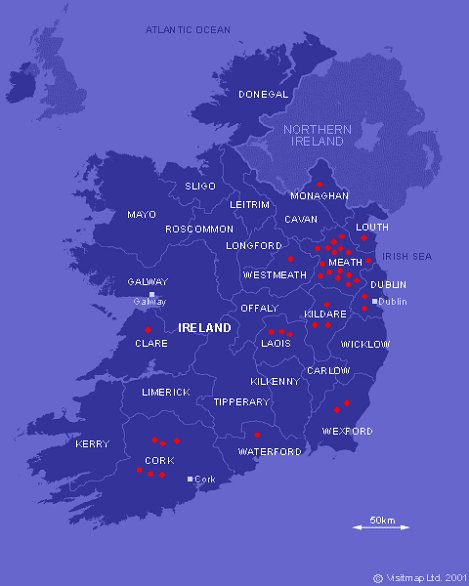_LOGO.jpg)
Our Work in Ireland
Irish Industrial Landscapes: Current Methodologies and Research Questions
The proliferation of excavations in Ireland over the last few years, have provided the Irish archaeological community and the public-at-large with a plethora of new data regarding metal making and working at all periods. By new data, we refer to both new dates as well as technical information by which to characterise and interpret the materials evidence, the features associated with metal making/working installations, the workshops and their relation to settlements, burial grounds etc.
The elucidation
of the metals industry, the subject of archaeometallurgical studies, has
relied on the scientific characterisation of metals and metallurgical waste
and the furnaces from which they derived. The research agenda has been driven
by questions of technology and provenance, while
the focal point of the investigation became the artefact, whether
raw materials, finished object, or waste (slag).
Since the late 1990's at SASAA, we have developed a methodology for the study of the metals industry which has shifted the emphasis from the artefact to the feature/context. We examine and analyse the context with a similar methodology/ analytical tools as if it were an artefact... i.e., we look at its typology, its “properties” and the chemical make-up of its soils and aggregates. Pivotal to the study of the context is the realisation that there is information to be derived from the technical characterisation of the soils within each context. It refers to the degree of heating they have undergone (magnetic susceptibility) or their phosphate or carbonate content reflecting domestic or other activities.
On SASAA's webpages, we provide guidance for sampling and recording of Irish "industrial sites" of any period and particularly with regards to metal-making and working.
SASAA recommends screening tests and analyses (T&A), which aim to quantitatively characterise relevant and related contexts/features.
We also recommend industrial waste analyses and metal artifact analyses which can be carried out independently on any materials (e.g. metal, slag, ceramics, etc.)
Please email us at... enquiries@sasaa.co.uk with your enquiry
SASAA Irish Early Metalworking Case Studies
SASAA has carried out extensive industrial waste and soils analysis on a number of sites. Selected sites are listed below and SASAA projects are indicated on the map.
 M4
Kinnegad-Enfield-Kilcock (KEK) Motorway Scheme (Counties Westmeath, Meath and
Kildare)
M4
Kinnegad-Enfield-Kilcock (KEK) Motorway Scheme (Counties Westmeath, Meath and
Kildare)
Ballycassey (licence number 02E1045)
Ballyonan (licence number 02E1087)
Griffinstown III (licence number 02E1144)
Hardwood III (licence number 02E1141)
Johnstown I (licence number 02E462)
Johnstown III (licence number 02E1094)
Kinnegad II (licence number 02E926)
Newcastle II (licence number 02E1093)
Rossan III (licence number 02E1065)
Rossan IV (licence number 02E1066)
Rossan V (licence number 02E1067)
Rossan VI (licence number 02E1068)
Killickaweeny (licence number 02E1002)
N8 Glanmire-Watergrasshill Road Scheme (County Cork)
Killydonoghoe (licence number 01E0481)
Site AR 15 (licence number 01E0633)
Site AR 16 (licence number 01E0111)
Sites AR 26 & 29 (licence number 01E0501)
N2 Finglas-Ashbourne Road Scheme (County Meath)
|
N25 Realignment Scheme
|
M7/M8 Motorway Scheme (County Laois)
|
|
Carrickmacross-Aclint Realignment Scheme
|
M1 Dundalk Western Bypass Motorway Scheme
|
|
|
Sites independent of road schemes
|